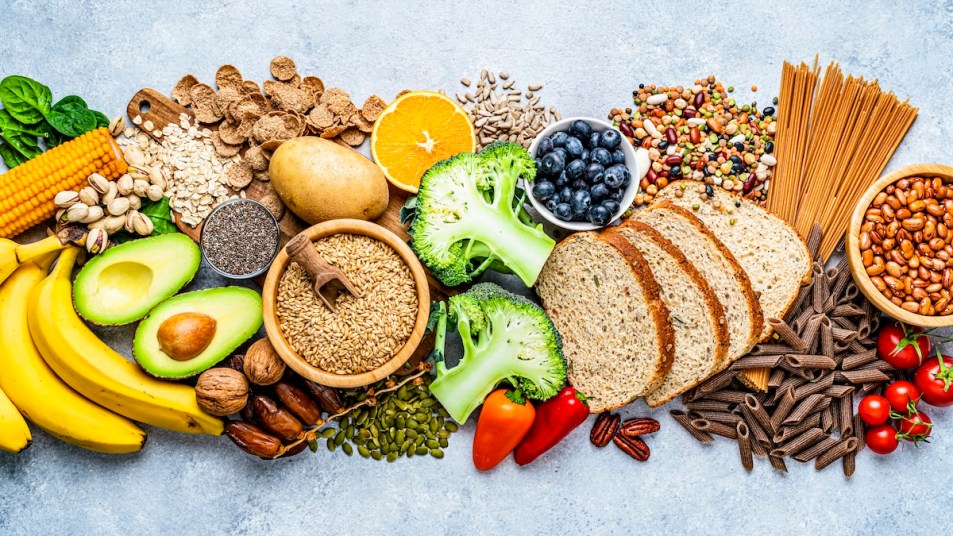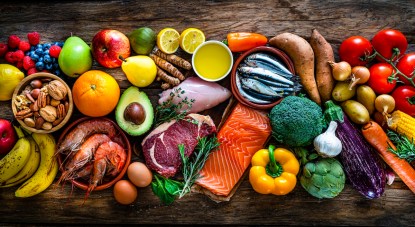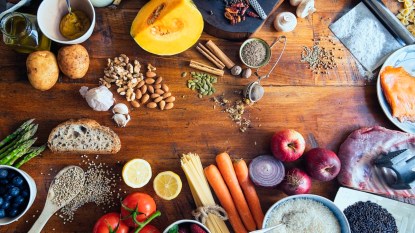The Anti-Inflammatory and Mediterranean Diets: Two Immune System-Boosting Diets That Don’t Skimp on Flavor
The Mediterranean and anti-inflammatory diets are popular and well-researched with both overlaps and key differences.

Chronic inflammation in the body is associated with a number of unwelcome conditions, such as Alzheimer’s, type 2 diabetes, arthritis, autoimmune diseases and more. What we put into our body is directly reflected in our overall well-being—which is why following an anti-inflammatory diet is so crucial to long-term health. Making intentional, nourishing choices when it comes to food can make a world of a difference, as both the anti-inflammatory and Mediterranean diets exemplify.
Integrative Registered Dietitian-Nutritionist Stephanie Dunne, MS, RDN, IFNCP explains to Women’s World that the objective of an anti-inflammatory diet is to take out “Those foods that are commonly known inflame or weaken the immune system, while including foods that are known to calm the immune system or make it stronger. In doing so, they reduce the burden on the immune system of what it’s trying to fight so it can focus on real problems like viruses.”
Resources for Anti-inflammatory and Mediterranean diets
There is no shortage of places to turn for pretty much anything you could want to help you start and stick to anti-inflammatory and Mediterranean diets, We’ve chosen a few that Woman’s World has experience with to get you on your way.
| Cookbooks | The Mediterranean Diet Cookbook for Two, one of the most popular Mediterranean diet cookbooks of all time The Complete Mediterranean Diet Cookbook for Beginners, great starter cookbook with easy recipes Anti-Inflammatory Drinks for Health, convenient smoothies, teas, and more The Anti-Inflammatory Diet for Beginners, easy recipes from a dietician |
| Meal Plans | Hungry Root, customizable meal plans for specific diets Green Chef, Mediterranean-specific meal plan with options |
| Snacks | Nature’s Garden, all-natural, nut-centered trail mix Anti-Inflammatea Loose Leaf Tea, tasty, all-organic tea Safe Catch, sustainable, low-mercury tinned seafood Taza Chocolate, ethically sourced, organic, low contaminate chocolate for snacking and baking |
| Sites | The Anti-Inflammatory Diet, Johns Hopkins Medicine The Mediterranean Diet, American Heart Association |
| Helpful Articles | Lose Up to 18 Pounds in 17 Days With These Tasty Anti-Inflammatory Diet Swaps, Woman’s World An Anti-Inflammation Diet Plan to Help You Lose Weight, Avoid Disease, and Fight Depression, First for Women Adele’s Doctor Details the Healthy Diet She Recommends for ‘Successful and Sustainable Weight Loss’, Us Weekly |
| Support | Anti-Inflammatory Diet For Beginners, popular Facebook group Mediterranean Diet for Beginners, popular Facebook group Anti-Inflammatory Foods, NutritionFacts.org YouTube channel |
Anti-Inflammatory and Mediterranean Diets: How They Match Up and Differ

| Anti-Inflammatory | Mediterranean | |
| Foods Included | Leafy greens; fruits; whole grains; nuts; fish; poultry; herbs and spices; dark chocolate | Legumes (beans), nuts, vegetables, fruits, whole grains, fish, extra virgin olive oil; red wine (once in a while) |
| Foods to Avoid | Alcohol; soft drinks; white bread/pasta, fried foods; red and processed meats; artificial sugars | Refined grains; red meat; processed foods; artificial sugars |
| Lifestyle | Regular exercise; stress management (meditation and breathing practices); getting plenty of sleep | Daily movement; meaningful connections; leisurely sit-down meals |
| Benefits | Weight loss; fights against chronic/autoimmune diseases; decreases risk of obesity, diabetes, cardiovascular conditions | Cardiovascular health; reduces cholesterol and blood pressure levels |
| Drawbacks | Groceries can be expensive; may be difficult to avoid foods when eating out or traveling | Buying fresh produce can get expensive |
The Anti-Inflammatory Diet Addresses Chronic Inflammation of the Cells
Stephanie Dunne explains what inflammation is and how it affects the body: “At the most fundamental level, inflammation is a reaction by the immune system to a real or perceived threat. We have systemic inflammation when we have an autoimmune disease that impacts the whole body, like psoriasis on the skin or rheumatoid arthritis in the joints.
Some foods are known to trigger an immune response, or inflammation, because the body perceives them as a threat. This is similar to how some people have seasonal allergies because the body sees pollen or grass as a threat and mounts an immune response to take down the perceived invader.
Stephanie Dunne

It’s Important to Choose the Right Foods
So what are the foods that supplement an anti-inflammatory diet? A good rule of thumb is to go for colorful, unprocessed foods and to prioritize protein and fiber. In particular, choosing a rainbow of fruits and vegetables is always optimal. Certified Culinary Medicine Specialist Dr. Anne VanBeber, PhD, RD, LD, FAND, explains: “Every color contains different phytonutrients or what we also call bio active ingredients. They work with our cells to boost the immune system and combat inflammation and disease.”
For example, dark leafy greens are an excellent diet staple to help reduce inflammation. These include spinach, kale, collard greens, bok choy and brussels sprouts. Their high levels of beta-carotene and cancer-fighting compounds have been proven to reduce inflammation in the body. Another easy-to-implement powerhouse of a food are berries. Blueberries in particular are rich in antioxidants. According to Dr. VanBeber, “their dark red and purple hues contain anthocyanin pigments, which are healthy for the whole body, especially the brain.”
Versatile anti-inflammatory kitchen staples to add to your shopping list
- Spinach, kale, arugula, brussels sprouts
- Quinoa, oats, farro, brown rice
- Nuts and olive oil
- Beans, lentils, peas
- Berries
- Sweet potatoes
- Tomatoes
- Herbs and spices
- Salmon, tuna, mackerel. sardines (choose low-mercury brands)
- Chicken
- Dark chocolate (in moderation)
Related: These 4 Anti-Inflammatory Recipes Can Help Fight Flare-Ups of Chronic Disease
Herbs and Spices Are Great For Fighting Inflammation, Too
Another underrated food to pay attention to: herbs and spices. Paprika, rosemary, turmeric, ginger, sage and oregano are excellent sources of antioxidants. Not only do these add a delicious variety of flavors to your dishes, they are chock full of disease-fighting nutrients and vitamins. Ginger, in particular, is powerful due to its abundance of inflammation-reducing active compounds. Studies have also found it to be effective in easing joint pain and inflammation.

Avoid These Inflammatory Foods
It’s also crucial to note which foods to stay away from in order to minimize inflammation in the body. Avoid anything high in sugar, salt, or saturated and trans- fats. Saturated fats are often found in meat and dairy, so we recommend reducing your intake of red meat and prioritizing poultry and omega-3 rich seafood instead. Some more inflammatory foods are: refined carbs (white bread and pasta), deep fried foods (French fries, donuts) and artificial added sugars as found in soda, candy, syrups.
Inflammatory foods to avoid
- Sugar
- Red meat (genuine grassfed meat may be an exception)
- Full-fat dairy
- Refined white flour and processed foods
- Fried food
- Artificial colors and sweeteners
[Avoid] “ultra-processed foods” such as bacon, most lunch meats and sausage, fried foods, most commercially baked goods, microwave popcorn, margarine, and non-dairy coffee creamer, believe it or not. This is why it is always important to read the nutrition labels to determine what’s in your food and what you’re consuming. It’s also important to limit alcohol since it can contribute to inflammation and, in excess, negatively impact overall gut health.
Dr. Brynna Connor, MD
Related: Lose Weight and Fight Disease With Dr. Andrew Weil’s Anti-inflammatory Diet
The Mediterranean Diet Already Includes Many Anti-Inflammatory Foods
Anti-inflammatory and Mediterranean diets align in almost all areas. They share many of the same principles—an abundance of antioxidants from fruits and vegetables; fiber from whole grains; essential fatty acids from fish, nuts and seeds. In addition, the Mediterranean diet stays away from processed or refined foods, encouraging naturally-derived whole foods instead. The Med diet does allow some things like limited consumption of red wine, which many people on an anti-inflammatory diet will want to stay away from, especially if you suffer from conditions like gout and arthritis.
[It] emphasizes plant-focused meals featuring a small portion of lean protein, typically fish or seafood, olive oil as the primary fat, and a higher focus on whole grains, fruit, and vegetables. Evidence shows that people following the Mediterranean diet have more stable blood sugar, lower cholesterol, and a lower risk for heart disease and dementia.
Dr. Bryanna Conor, MD

It’s Mostly Plant-Based, With Plenty of Healthy Fats
The Med diet keeps consumption of dairy and red meat to a minimum, while fiber and protein is derived largely from a significant focus on legumes. Dr. VanBeber commends beans and legumes for being, “One of the healthiest foods. Every healthy culture consumes some type of bean, like pinto, black, kidney, red, northern, navy, chickpea. These can be added to foods you already eat. They are an excellent and inexpensive protein source. They contain a lot of fiber and resistant starch, which help to keep our colon and our gut healthy.”
Some foods you can pick up at the store include:
- Olive oil, avocados
- Salmon, tuna, white fish
- Chickpeas, lentils, beans
- Tomatoes, kale, broccoli, carrots, sweet potatoes
- Oatmeal, brown rice, whole wheat bread and pasta
- Berries, apples, figs
- Almonds, walnuts, sunflower seeds
Related: Top Doc: Eating Beans Can Help Fight Chronic Arthritis Pain
Benefits Include Lowered Risk of Heart Disease, Dementia, Cancer And More
Time and time again, research has proved the Mediterranean diet’s instrumental role in resisting diseases and improving your quality of life. Eating foods so rich in a diverse array of minerals, vitamins and antioxidants on a daily basis inevitably enhances the functioning of our immune system.
Diet is not the only factor at play for these incredible benefits. The Mediterranean diet’s lifestyle factors come into play as well: Research shows that walking consistently, slowing down to enjoy meals and establishing strong connections with family and friends all promote longevity.
Related: Blue Zones and Mediterranean Diets: What the Longest Living Populations Are Doing Right

The Anti-Inflammatory and Mediterranean Diets Both Have Great Recipes
All of these recipes cover so many of the foods that are perfect for both anti-inflammatory and Mediterranean diets, and have been reviewed in the Women’s World kitchens!
- Sweet Potato Chili, only seven affordable ingredients in and packed with antioxidants and flavor, plus there’s only 15 minutes of prep time before you throw it all in a pot!
- Easy Spiced Chicken and Chickpeas, chickpeas, yogurt, Middle Eastern spices make it delicious and quick. Add 1/2 cup slivered walnuts for extra texture, flavor and nutrition.
- Saucy Sesame Chicken and Vegetables, classic Asian flavors with ingredients easy to find at the supermarket. Sesame oil is a healthy and flavorful anti-inflammatory new favorite.
- One-Pot Lentil Stew, a great make-ahead, crock pot, or slow cooker one to prep and forget, or throw into the freezer. Plus it’s less than $1 per serving.
- Egg White Frittata Bites, appealing, filling—and low in calories. Why not make them for brunch on Sunday and enjoy the leftovers for breakfast on Monday?
- Chickpea Cookie Dough. Really? Yes! It’s startlingly good, check out the success stories for this guilt-free and diet friendly treat.
Anti-inflammatory and Mediterranean diets are Incredible Sources of Tasty, Whole Foods and Disease-Fighting Nutrients
Anti-inflammatory and Mediterranean diets prove that foods can be nourishing and good for you, while still being full of flavor, too. Although you may miss the fries and soda, the implementation of herbs and spices like garlic, onions and ginger means dishes won’t be lacking in flavor. Plus, they help to boost immunity.
The Mediterranean diet deviates from the standard anti-inflammatory diet in small ways, and is overall less restrictive However, it can still be considered an anti-inflammatory-friendly diet as its foods significantly help to combat inflammation in the body. Research has connected both diets’ patterns of eating—fresh vegetables and fruits, minimal red meat consumption, lots of omega-3’s and fiber—to much lowered levels of inflammation in the body.
Both focus on plant-based meals that feature fish as a primary source of protein and place an emphasis on whole grains, fruits, and vegetables. However, an anti-inflammatory diet is slightly more narrow in its approach, while the Mediterranean diet incorporates foods from throughout the Mediterranean region.”
Dr. Brynna Connor, MD
She continues to explain that in addition to maintaining a healthy weight, anti-inflammatory diets can aid in boosting overall energy levels and mental clarity. They’ve also been shown to help protect the brain prevent changes that can lead to dementia, and reduce the risk of other serious health conditions like heart disease and diabetes.
Both anti-inflammatory and Mediterranean diets can run up an expensive grocery bill. After all, buying fresh and organic produce and whole foods does not typically run cheap.
However, the food list (and cost) can be adjusted accordingly for your budget—frozen fruits and vegetables, canned beans, sardines and tuna come at an affordable price and still fit within the diets’ guidelines. Plus, since meat is not a central focus of this diet, that can minimize grocery costs as it tends to be the most expensive food to purchase.
Yes. Both diets already emphasize a plant-forward eating pattern so cutting out meat and dairy products should not be a challenge. Consider replacing these protein sources with plant protein such as lentils, tofu, beans, hemp seeds and more.
Consistently eating in a way that prioritizes fruits and vegetables, whole foods and protein while minimizing processed foods like cookies, crackers and fried foods will naturally lead to a more balanced weight. Implementing these healthy food choices into your daily life will also only improve gut health, boosting digestion and metabolism.
Related:
Blue Zones and Mediterranean Diets: What the Longest Living Populations Are Doing Right
Paleo vs. Mediterranean Diet: Colorful Foods with Varying Flexibilities
This content is not a substitute for professional medical advice or diagnosis. Always consult your physician before pursuing any treatment plan.













